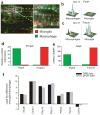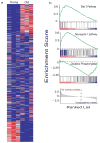The microglial sensome revealed by direct RNA sequencing
- PMID: 24162652
- PMCID: PMC3840123
- DOI: 10.1038/nn.3554
The microglial sensome revealed by direct RNA sequencing
Abstract
Microglia, the principal neuroimmune sentinels of the brain, continuously sense changes in their environment and respond to invading pathogens, toxins and cellular debris. Microglia exhibit plasticity and can assume neurotoxic or neuroprotective priming states that determine their responses to danger. We used direct RNA sequencing, without amplification or cDNA synthesis, to determine the quantitative transcriptomes of microglia of healthy adult and aged mice. We validated our findings using fluorescence dual in situ hybridization, unbiased proteomic analysis and quantitative PCR. We found that microglia have a distinct transcriptomic signature and express a unique cluster of transcripts encoding proteins for sensing endogenous ligands and microbes that we refer to as the sensome. With aging, sensome transcripts for endogenous ligand recognition were downregulated, whereas those involved in microbe recognition and host defense were upregulated. In addition, aging was associated with an overall increase in the expression of microglial genes involved in neuroprotection.
Figures








References
-
- Lawson LJ, Perry VH, Dri P, Gordon S. Heterogeneity in the distribution and morphology of microglia in the normal adult mouse brain. Neuroscience. 1990;39:151–70. - PubMed
-
- El Khoury J, et al. Ccr2 deficiency impairs microglial accumulation and accelerates progression of Alzheimer-like disease. Nat Med. 2007;13:432–8. - PubMed
-
- Rezaie P, Male D. Mesoglia & microglia--a historical review of the concept of mononuclear phagocytes within the central nervous system. J Hist Neurosci. 2002;11:325–74. - PubMed
-
- Nimmerjahn A, Kirchhoff F, Helmchen F. Resting microglial cells are highly dynamic surveillants of brain parenchyma in vivo. Science. 2005;308:1314–8. - PubMed
-
- Block ML, Zecca L, Hong JS. Microglia-mediated neurotoxicity: uncovering the molecular mechanisms. Nat Rev Neurosci. 2007;8:57–69. - PubMed
Publication types
MeSH terms
Substances
Grants and funding
LinkOut - more resources
Full Text Sources
Other Literature Sources

